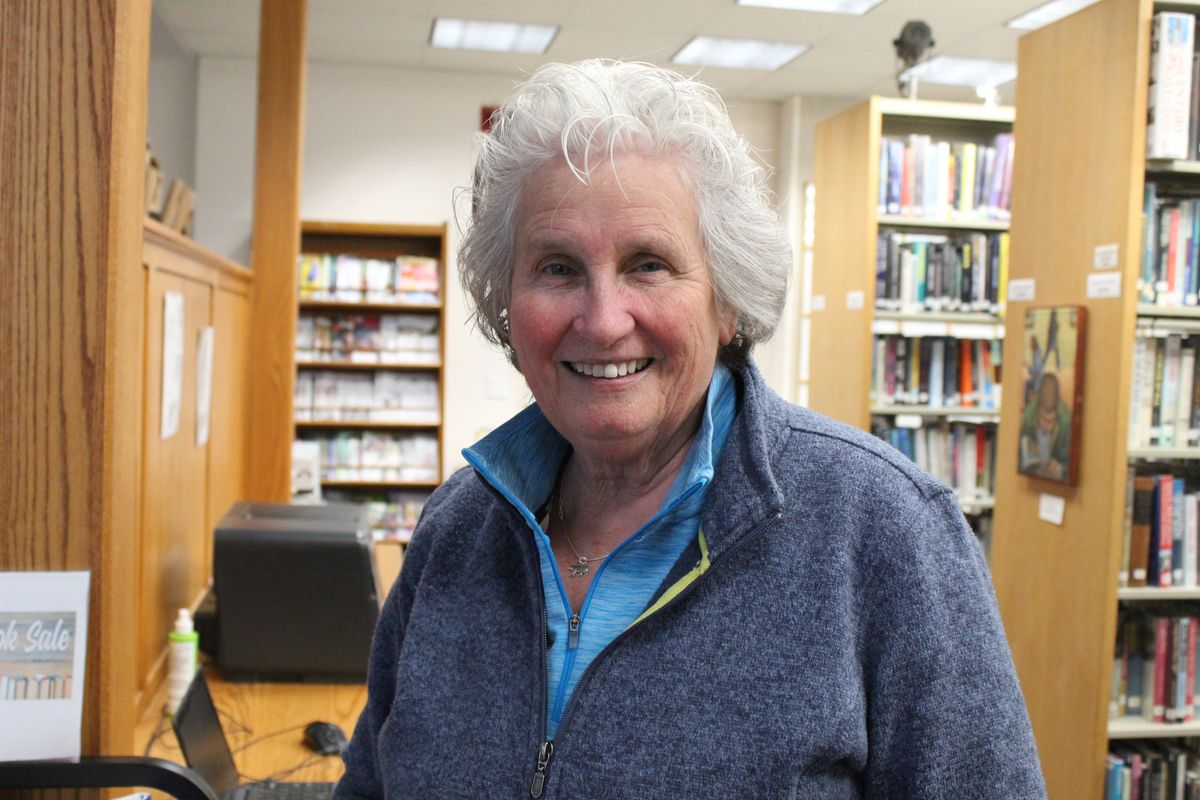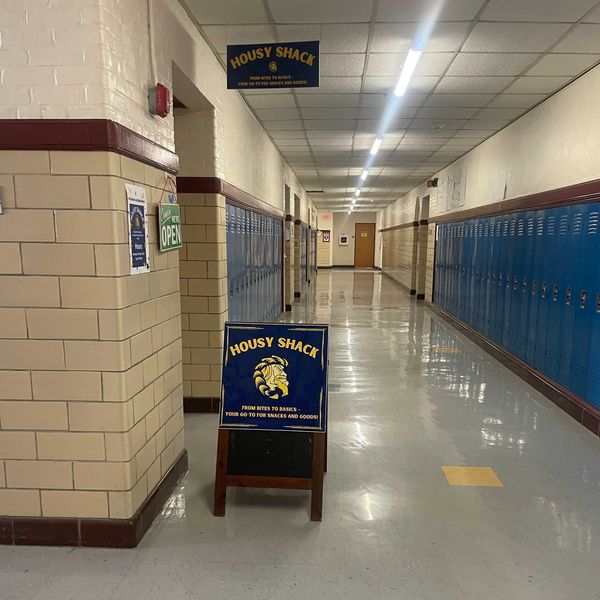State to study ‘dwindling’ gray fox population in Connecticut

Ginny Apple’s recent fox lesson at David M. Hunt Library included audio effects.
Patrick L. Sullivan

Ginny Apple’s recent fox lesson at David M. Hunt Library included audio effects.
FALLS VILLAGE — Ginny Apple, a master wildlife conservationist with the state Department of Energy and Environmental Protection, told a capacity crowd all about Connecticut’s foxes at the David M. Hunt Library on Saturday, March 1.
Apple focused on the red and gray fox, the two species most likely encountered in the state.
She said the gray fox population is “dwindling” and that DEEP is about to start a study using electronic collars that track the animals in an effort to find out why their numbers are down.
Apple had a pretty good guess, though: rodenticides.
Mice and other rodents are significant food sources for foxes of all kinds. The bait that homeowners use to kill house mice often results in the poisoned mice stumbling outside and being eaten by foxes.
Apple conceded using snap traps or live traps is cumbersome and likely less effective.
She suggested that live mice could be trapped and then relocated some miles away, in a spot that provides some cover “so they have some chance” at survival.
Mice do have a homing instinct so it doesn’t do much good to just shake them out of the live trap in the back yard, she said.
Lead shot in deer carcasses is another problem. Foxes come across a deer that was shot by hunters and expired but never collected. The foxes eat the meat, and with it the lead shot.
Northwest Corner residents are most likely to see a red fox. Red foxes are bigger than their gray fox cousins, but rarely exceed 12 pounds.
They are adaptable animals, and are not put off by human habitation.
In fact, one very common place to find a den of red fox mothers and kits is under an outbuilding.
If that happens, Apple says the best thing to do is leave them alone, as they will move on once the youngsters are ready.
If it is not possible to host a fox family under the woodshed, the best way to get them to leave is to be noisy.
Apple is an advocate of the Bear Scare Can treatment for scaring off unwanted wildlife.
“That’s a coffee can with coins in it,” she said. “ It makes an unnatural sound.”
She said air horns sound too much like car horns, which foxes are often accustomed to.
Both gray and red foxes enjoy excellent eyesight, hearing and sense of smell.
“They can hear a small animal burrowing at 150 yards.”
She played a sample of fox sounds — a collection of howls, barks, whines and one yowl that Apple says provokes a lot of calls to 911.
One woman in the audience said it sounded like someone being murdered off in the woods.
The Community Closet at HVRHS is open for students to take clothes for any reason during the school day.
What started with one unexpected donation of clothes has grown into a quietly impactful resource for all students at HVRHS: the Community Closet. Now located in a spacious area above the cafeteria, the closet offers free clothing to any student for any reason.
The idea began a few years ago when a community member reached out to the former superintendent wondering if anyone at the school could benefit from used clothing that would otherwise go to waste. The superintendent then got in contact with Rachel Novak, the school social worker. “Once I had all those bags of clothes in my room, I was like, ‘I should put this in a space,’” Novak said. Her simple idea eventually became a full-sized closet accessible to all students.
From the beginning, Novak envisioned the closet as an inclusive space. “It’s open to anybody, it’s not just based on economic needs,” she said. Sustainability also plays a role. “Thinking about the environment, some students like to thrift and just get clothes that way,” Novak said.
After the initial donation, contributions continued to grow. “I reached out to our staff members and faculty,” Novak said. The most consistent donations come from the faculty at HVRHS and a few community members who learned about the closet. Finding teenage-appropriate clothes has been a challenge. “I get a lot of donations that are nice, but I don’t think teenagers would want to wear them,” Novak said.
Another ongoing obstacle has been awareness. Many students don’t know the closet exists at all. “That’s been the hard part,” Novak said. “Getting it out to the wider community of the school.” Novak is looking for students and staff to spread the word. “It helps because our school nurse knows and other faculty members,” she said. “When they know a student needs something, they just bring them up.”
Looking ahead, she hopes to promote the space more actively. “When we come back from this break, I do plan to … get fliers and all that up and going,” Novak said. There may even be an upcoming expansion — she has discussed the possibility of turning part of the area into a food pantry. “That would be more of a need-based system for students,” she said. “But right now, promoting it is where I’m at.”
The Community Closet is well-stocked currently. “Just because of the amount of clothes I have, I’m not accepting any more donations until I clear some stuff out,” Novak said. She is still willing to make room for more fashionable, teen-friendly items donated by students. “That way I’ll have more teenager approved clothes.”
Above all, she wants students to know that no one is limited to using the space. “Sometimes there’s a stigma around it … like, ‘I don’t need help. I don’t want to take away from anybody else that may need it,’” Novak said. Due to the amount of clothes, students should feel welcome to use the closet for any reason. Some students even grab items last minute for sports and activities. “It’s important for kids to know it’s for everyone.”
Whether a student wants to thrift clothes sustainably, forgot to pack clothes for an after-school practice, or is in need of a new outfit, the Community Closet is a resource for all.
Sophomore Eliana Lang enjoys her Housy Shack cookie.
Now in its second year, the Housy Shack is a hit among students. The special education department-run store that sells warm cookies, drinks and other snacks to students and teachers draws people to a room in the back hallway every time it’s open.
The smell of warm cookies welcomes visitors to the store with snacks, drinks and even Housy merchandise for sale. The cookies are definitely the favorite, sometimes lines go out the door to get one before they sell out.
The cookies are so popular that the store had to increase prices from 50 cents to a dollar and implement a four cookie per person maximum. The Shack sells about 40-100 cookies per day and has about 20-60 HVRHS customers visiting per day.
Julie Browning and Heather Strid, two of the HVRHS faculty members that help run the Shack, said their goal was to create real-world job experiences as well as real-world shopping experiences for students at HVRHS. “Learning the skills to work in the world can be taught in a classroom, but the lessons are more meaningful and valuable when they are applied in real work situations, which is what we create through the school store,” Browning said.
The original purpose for the store seems to be working, as several students are learning important skills. Students said the store taught them skills like counting money, checking inventory and cleanliness along with social skills and customer service that could help in the professional world after high school.

As the store quickly became a hit, organizers were faced with the challenge of finding funding. “When we started planning to start the school store two years ago we needed money to buy equipment, supplies and food to start it up but were not sure how to get it,” Browning said. “Mrs. Strid came up with the idea of applying for a grant from the 21st Century Fund to help us get started and they were so generous.” That grant has been crucial to the success and growth of the school store.
Not only does the Housy Shack benefit the special education department, students said it fosters a sense of community throughout the school. “School store cookies are my favorite thing ever. They brighten up my day,” said Eliana Lang, a sophomore at HVRHS. Dayana, one of the student staffers at the Housy Shack, said her favorite part of working in the school store is when students come in to make purchases. She enjoys talking to them and ringing up their orders on the cash register. The Housy Shack brings people together and offers the opportunity for students to connect with each other.
As the school year continues, the members of the school store look forward to expanding their inventory by creating and selling a variety of Housy merchandise — t-shirts, sweatshirts, water bottles, and more. “I have had several students put in requests for certain hats, key chains, etc. … so there will be more of that to come,” Browning said. Last school year, profits were all invested back into the school store. “This year we are hoping to make more of a profit and will look to use the money that we make for field trips, outings as well as opportunities to donate and give back to the community,” Browning said. They also would like to use the school store to fundraise for other causes. “Right now we are collecting donations for The Little Guild Animal Shelter, so if anyone has pet supplies they would like to donate please drop them off in exchange for a cookie,” Browning said.